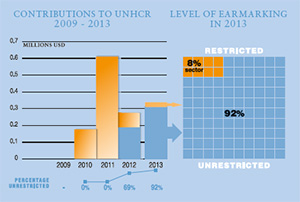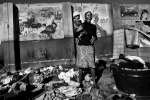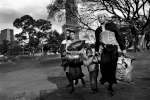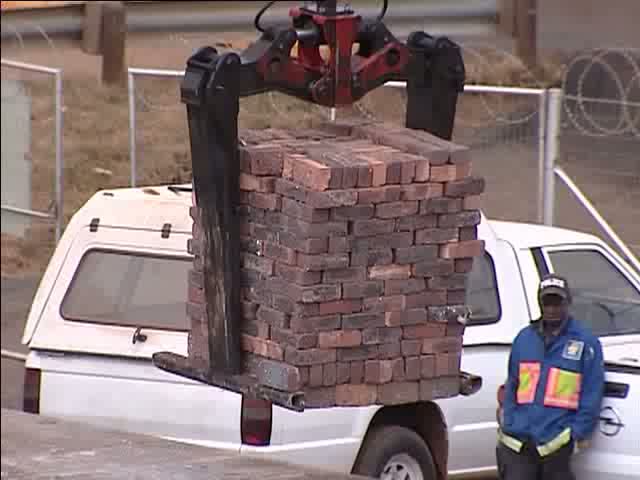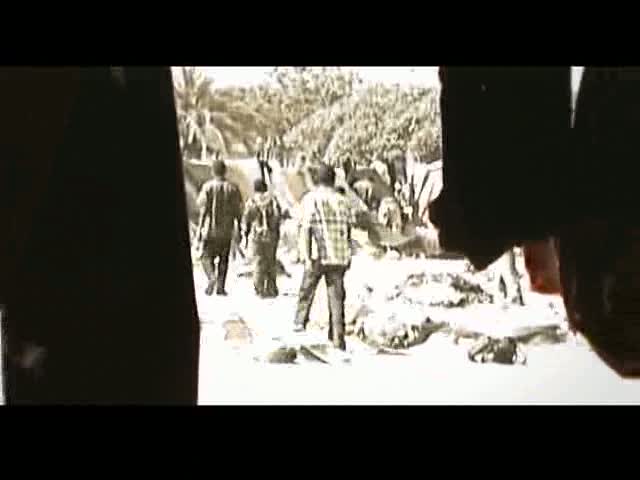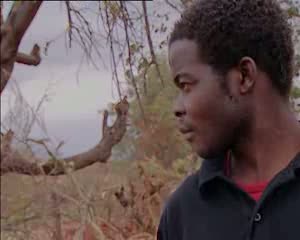Home > Where We Work > Africa > Southern Africa > South Africa
2015 UNHCR country operations profile - South Africa
| Overview |
Working environment
-
South Africa's national legislation incorporates the basic principles of refugee protection, including freedom of movement, the right to work, and access to basic social services. However, some public institutions do not recognize refugees' permits, preventing them from benefitting fully from these rights. The current socio-economic environment - high unemployment, poor service delivery, and economic inequality - has strained relations between refugees, asylum-seekers and host populations.
-
Reaching refugees remains a challenge for UNHCR as most reside in urban areas.
-
South Africa continues to be a major destination for asylum-seekers, as well as migrants and others seeking better economic and social opportunities. There are confirmed reports of human smuggling and trafficking.
-
The asylum system is overwhelmed. The large number of applications has created a backlog, affecting the quality and efficiency of refugee status determination (RSD). Without a comprehensive immigration system, migrant workers and others sometimes try to make use of the asylum system to stay legally and gain access to South Africa's services. The Government is establishing a border-management agency to regulate immigration and, in July 2014, new regulations came into effect.
-
RSD is carried out by the South African Government. In 2015, it will continue to support international efforts to protect and assist refugees through providing access to health facilities, schools and social services.
People of concern
The majority of refugees and asylum-seekers in the South Africa operation have fled the conflict in the Democratic Republic of the Congo, the security situation in Somalia or are individuals who claim to have faced persecution in Burundi, Ethiopia, Rwanda and Zimbabwe.
There are approximately 65,000 recognized refugees in South Africa. Many of them have been there for years. In addition, at the end of 2013, there were 230,000 asylum-seekers awaiting decisions, according to Department of Home Affairs figures.
In January 2014, the Government of South Africa publicly stated that it is considering a visa for Southern Africa Development Community (SADC) economic migrants, which may reduce new asylum applications.
| UNHCR 2015 planning figures for South Africa | |||||
|---|---|---|---|---|---|
| Type of population | Origin | January 2015 | December 2015 | ||
| Total in country | Of whom assisted by UNHCR |
Total in country | Of whom assisted by UNHCR |
||
| Total | 315,000 | 63,000 | 331,500 | 66,300 | |
| Refugees | Dem. Rep. of the Congo | 15,000 | 3,000 | 16,000 | 3,200 |
| Ethiopia | 9,600 | 1,920 | 11,600 | 2,320 | |
| Somalia | 24,000 | 4,800 | 27,000 | 5,400 | |
| Various | 20,400 | 4,080 | 22,900 | 4,580 | |
| Asylum-seekers | Dem. Rep. of the Congo | 8,500 | 1,700 | 9,000 | 1,800 |
| Ethiopia | 4,600 | 920 | 4,400 | 880 | |
| Various | 189,900 | 37,980 | 194,600 | 38,920 | |
| Zimbabwe | 43,000 | 8,600 | 46,000 | 9,200 | |
| Response |
Needs and strategies
The main needs of refugees remain access to: documentation; a fair and functioning asylum system; basic social services, provided in national legislation and policy; occasional emergency assistance for the most vulnerable, including shelter and food; and social cohesion programmes.
UNHCR's approach continues to focus on enhancing strategic partnerships and strengthening coordination in its main areas of intervention. In 2015, the Office will advocate that the current asylum space be preserved, allowing refugees and asylum-seekers to work, study and access health and social services. UNHCR will continue to provide technical support and advice to the Department of Home Affairs, promote self-reliance, and enable local integration. Short-term material assistance will be provided for vulnerable refugees and asylum-seekers who cannot access other essential assistance, such as shelter and food, until they can benefit from local charitable or governmental social services.
The Office will intensify efforts to ensure that survivors of sexual and gender-based violence receive the necessary support and assistance. Resettlement will continue to be a protection tool for individuals with critical needs. Special efforts will be made to pursue preventive actions and advocacy, including awareness campaigns, conflict resolution programmes and other community interventions aimed at promoting social cohesion.
| Implementation |
Coordination
UNHCR's main partner in South Africa will continue to be the Department of Home Affairs. Cooperation is established through the Department of International Relations and Cooperation (DIRCO). Development actors will help create livelihood opportunities. As the lead agency for the Protection Working Group, UNHCR will provide strategic leadership and direction on international protection issues. It will continue to collaborate closely with relevant Government authorities, other UN agencies, civil society, and other stakeholders. UNHCR is involved in the elaboration and implementation of the UN Strategic Cooperation Framework (UNSCF) with sister UN agencies and the Government.
| 2015 UNHCR partners in South Africa |
|---|
| Implementing partners |
| NGOs: The Agency for Refugee Education, Skills Training and Advocacy; Cape Town Refugee Centre, Caritas Swaziland, Centre for the Study of Violence and Reconciliation, Displaced and Migrants Persons Support Programme, Future Families, Jesuit Refugee Service; Lawyers for Human Rights and Refugee Social Services, the Study Trust. |
| Others: Nelson Mandela Metropolitan University, University of Cape Town (UCT) - Refugee Rights Clinic |
| Operational partners |
| Government agencies: City Councils of Cape Town, Durban, Johannesburg, Polokwane and Tshwane; Department of Basic Education; Department of Health; Department of Home Affairs; Department of International Relations and Cooperation; Department of Social Development; national and provincial disaster management centres; provincial Governments of Gauteng, Eastern Cape, KwaZuluNatal, Limpopo, and Western Cape; South Africa Social Security Agency, South African Police Service, and the South African Human Rights Commission |
| NGOs: Black Sash, Child Welfare South Africa, Childline South Africa, Consortium for Refugees and Migrants in South Africa, ICMC, Lifeline, National Alliance for the Development of Community Advice Offices, RefugePoint, Sonke Gender Justice, Save the Children, and Scalabrini |
| Others: ICMC, ICRC, African Centre for Migration and Society (ACMS), IOM, UN Information Center, UNAIDS, UNDP, UNFPA, UNICEF, OCHA, and the University of South Africa (UNISA) |
| Financial information |
A significant drop in new asylum-seeker arrivals has led to a decrease in requirements, from USD 37.6 million in 2013 to USD 26.7 million in 2014.
In 2015, the comprehensive-needs budget has increased by three per cent to USD 27.3 million, due to a rise in the cost of living and fuel prices, as well as to the inclusion of a budget for Namibia where UNHCR's presence is expected to be phased out by mid-2015.
This budget has been drawn up to address: regional resettlement projects; the RSD process; registration of people of concern; public information and voluntary repatriation; the protection and assistance of refugees and asylum-seekers in urban areas of South Africa; and programmes to address statelessness in the region.
Source: UNHCR Global Appeal 2015 Update



